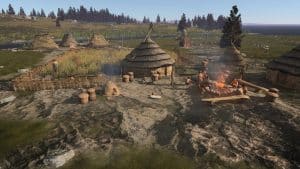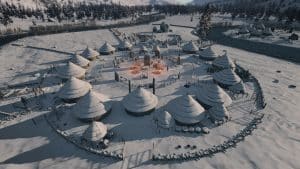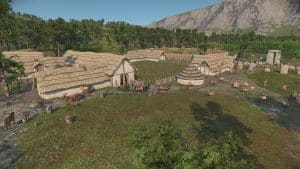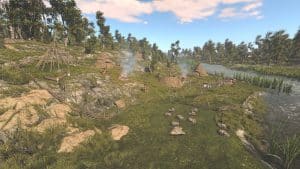Ancient Cities
Related Games
Description
🔥 What is Ancient Cities
Ancient Cities is a survival-focused city builder set in the Neolithic era, where players guide a hunter-gatherer tribe toward urban development through innovation and resource management. The experience combines ecosystem-driven simulation, genealogical evolution, and cultural tribulations that shape a developing society. The game originally released in March 2023 and presents itself as an evolving platform for future era expansions beyond the Late Stone Age.
Citizens possess individual attributes, memory, and social preferences residents may even emigrate if governance fails to align with their values. Players manage technology progression, seasonal cycles, weather, and resource decay within a procedurally generated world spanning Europe. Cultural systems such as religion, festivals, and family hierarchies emerge dynamically with population growth and technological advancement.
👉 Features of Ancient Cities
Tribe Evolution and Technological Trajectory
Starting in the Mesolithic age, players unlock early agriculture, animal domestication, and pottery to shift from nomadic subsistence toward settlement permanence. These technological leaps alter resource flow, work distribution, and social roles across generations.
Advancing through defined eras gradually unlocks new building types, defensive structures, and rituals. Culture may evolve in different directions depending on in-game decisions and external influences.
Advanced Simulation with Real Systems
The world includes seasons, plant and animal life cycles, weather events, and soil fertility all simulated to reflect authenticity and challenge. Citizens must manage tools, food spoilage, and infrastructure degradation, creating systemic realism even in early expansions.
Organic city layouts respond to terrain and resource nodes rather than grid-based planning. The settlement feels alive as the game rewards adapting to nature rather than reshaping it.
Migration, Diplomacy, and Regional Dynamics
Players can choose migration over expansion when resources become scarce, relocating the clan to more fertile regions. Interaction with neighbouring tribes includes trade, alliances, conflict, or assimilation, though combat systems remain simplified.
Culture can evolve toward matriarchal or patriarchal structures depending on internal dynamics. Decisions affect the tribe’s social balance, development, and future trajectory.
Gameplay
Survival City-Building Mechanics
Players construct basic huts, storage containers, hearths, and ritual spaces while managing food routes, artisan production, and labour assignments. Tribespeople act autonomously based on skills, preferences, and social ties.
Repetitive micromanagement is reduced as skilled citizens self-manage unless priorities change. Over time, generational shifts alter available labour, skills, and leadership roles.
Early Access Limitations and Community Feedback
While the ambition of cross-era progression is evident, many players report a skeletal framework with limited building types and trivial threat logic. Bugs and odd character behaviors occasionally disrupt immersion.
Review feedback points to a steep price relative to content and slow fulfillment of roadmap promises. Despite that, the core simulation offers a strong foundation with potential for future depth.
Graphics and Presentation
Realistic Tribal Ambience
The visual style uses detailed environments with grass, foliage, and ritual spaces that evolve over seasons. Camps feel organic, with villagers resting, children playing, and fires flickering enhancing immersion in the Neolithic setting.
Yet graphical polish remains rough in some areas: minimal animation variety, occasional terrain glitches, and limited building asset diversity. The scale of development remains modest relative to modern city-builders.
Audio and Environmental Feedback
Audio ambiance includes crackling fires, wind rustle, wildlife calls, and labor cues. These elements convey a living ecosystem even in its early stages.
Voice or narration is absent, reinforcing observation-based storytelling rather than exposition. Environmental sound plays a critical role in immersion and feedback.
Pros and Cons
✔️ Pros
- Ambitious ambition to simulate tribe evolution across eras
- High realism in citizen behavior, inheritance, and cultural continuity
- Ecosystem simulation adds life through seasonal change and animal cycles
- Migration, trade, and diplomacy choices add strategic depth
- Potential for future expansions offers long-term community engagement
❌ Cons
- Game currently offers minimal building types and shallow progression
- Bugs and odd logic, such as excessive rabbit invasions, undermine immersion
- Early Access pricing criticized relative to available content
- Civic systems such as religion or class remain underdeveloped
- Gameplay loop limited, making long-form interest difficult to sustain
ℹ️ Game information
Release Date: 24/03/2023
Update Date: 12/08/2025
Version: v1.7.34
Genre: Simulation / Strategy
Platform: PC
Language: ![]()
![]()
![]()
![]()
![]()
![]()
![]()
![]()
Weight: 6 GB
Additional info: New version includes all DLCs to date
⭐ Installation Instructions
- The game is fully complete, you just need to install it, so there is no need to unpack it or download it from other sources.
- Just run the Ancient Cities.exe installation file.
- Simply launch the game from shortcut desktop.
⚙️ System Requirements
✅ Minimum:
- OS: Windows 10 64bits
- Processor: Intel® i7-6700 / AMD® Ryzen 5 1600
- Memory: 6 GB RAM
- Graphics: NVIDIA® GeForce® GTX 1050 (2 GB) / AMD® Radeon™ RX-560 (4 GB)
- DirectX: Version 11
- Network: Broadband Internet connection
- Storage: 6 GB available space
✅ Recommended:
- OS: Windows 10 64bits
- Processor: Intel® i5-10400 / AMD® Ryzen 5 3600
- Memory: 8 GB RAM
- Graphics: NVIDIA® GeForce® GTX 1070 (8 GB) / AMD® Radeon™ RX 590 (8 GB)
- DirectX: Version 11
- Network: Broadband Internet connection
- Storage: 6 GB available space
Images







